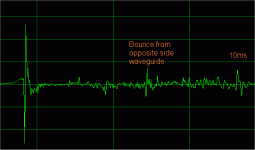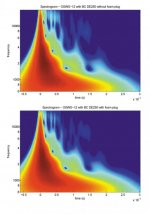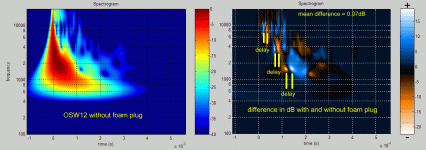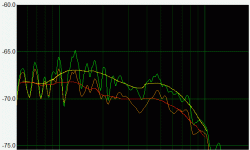Yeah I've noticed that the three Johns seem to think alike
(John Sheerin, John Hasquin, and me (who's name is John, not Patrick.)
Would someone with more experience than me critique my waveguide based on this plot? It shows 10 degree increments from 0 to 90. No crossover.
The baffle appears the same top, left and right, so I will therefore assume that this plot is a representative sample, and calculate a power response from it. I plan to feed that power response into my crossover simulator. Does this seem reasonable?
I'm guessing that this waveguide is very small, the axial hole is very low in frequency. I also suspect that there are some sharp edges or some room reflections because the response is rather rough. But its a good start.
Thank you.
I have plotted the power responses, simmed and crossed. In dealing with the acoustic phase I have boosted the tweeter by 2-3dB over target at 1500Hz. As this would have affected the power response, I may try undoing that and notching out the woofer instead.
Regarding baffle steps, I used to apply a simmed baffle step correction to an on axis plot, but now I see that this is close to pointless. BTW If anything, my bass is too high.
I rolled off the top end (4dB down at 10kHz). I'm still tweaking, but I just prefer it this way.
I have plotted the power responses, simmed and crossed. In dealing with the acoustic phase I have boosted the tweeter by 2-3dB over target at 1500Hz. As this would have affected the power response, I may try undoing that and notching out the woofer instead.
Regarding baffle steps, I used to apply a simmed baffle step correction to an on axis plot, but now I see that this is close to pointless. BTW If anything, my bass is too high.
I rolled off the top end (4dB down at 10kHz). I'm still tweaking, but I just prefer it this way.
Hard to see
While I have no reason to doubt you, it is hard to compare the differences in the figures without knowing the colour key. Could the ratio be plotted, or the figures normalised to the same peak value? (Or some other means to allow comparison of the change at >5kHz with the change at <1kHz, which you say is the same).
Ken
OS 12" with and without foam plug (Bulpren S28190). It seems foam attenuates uniformly.
While I have no reason to doubt you, it is hard to compare the differences in the figures without knowing the colour key. Could the ratio be plotted, or the figures normalised to the same peak value? (Or some other means to allow comparison of the change at >5kHz with the change at <1kHz, which you say is the same).
Ken
I should mention that one I sent wasn't perfect because I had to temporarily fix the foam in place so I used some material I had on hand. It may affect the result. When done a bit more carefully there is a very even 2 db loss up to 10k, and above that point it increases by an extra 1db, so a maximum attenuation of 3db above 10k. I found the same thing with a 6" oblate, the 12" and the 18 sound elliptical.
Hello,
I could derived a differential spectrogram from the impulse responses of the OSWG12 with and without foam.
(see attached)
(Note: the mean power of the response around t = 0 has been normalized to the same level for the waveguide without the foam plug and the waveguide with the foam plug.)
The blue color corresponds to the time/frequency domains for which the foam reduced some energy and the red color corresponds to the time/frequency domains for which the foam added some energy.
The white spots are the domains where the foam has the most effect.
The mean decrease of energy over all the time/frequency domain is less than 0.07dB.
Give a look to the white spots related respectively to a reduction and a rise in the level. They are grouped by 2 and inside each couple there is a delay between them.
A rapid conclusion to be improved by other analysis is that:
- the main effect of the foam plug is to delay some reflections, diffractions or HOMs inside the waveguide. Relative absorption of reflection, diffraction and HOMs versus the direct wave is negligeible.
Best regards from Paris, France
Jean-Michel Le Cléac'h
I could derived a differential spectrogram from the impulse responses of the OSWG12 with and without foam.
(see attached)
(Note: the mean power of the response around t = 0 has been normalized to the same level for the waveguide without the foam plug and the waveguide with the foam plug.)
The blue color corresponds to the time/frequency domains for which the foam reduced some energy and the red color corresponds to the time/frequency domains for which the foam added some energy.
The white spots are the domains where the foam has the most effect.
The mean decrease of energy over all the time/frequency domain is less than 0.07dB.
Give a look to the white spots related respectively to a reduction and a rise in the level. They are grouped by 2 and inside each couple there is a delay between them.
A rapid conclusion to be improved by other analysis is that:
- the main effect of the foam plug is to delay some reflections, diffractions or HOMs inside the waveguide. Relative absorption of reflection, diffraction and HOMs versus the direct wave is negligeible.
Best regards from Paris, France
Jean-Michel Le Cléac'h
Attachments
Last edited:
I hope Jack Zagaja will not be offended that I share the impulse response he sent to me. Jean-Michel Le Cléac'h
Data was kindly provided by Paulspencer. Alternative data: File size: 59.30 KB
Hello,
The white spots are the domains where the foam has the most effect.
The mean decrease of energy over all the time/frequency domain is less than 0.07dB.
Give a look to the white spots related respectively to a reduction and a rise in the level. They are grouped by 2 and inside each couple there is a delay between them.
A rapid conclusion to be improved by other analysis is that:
- the main effect of the foam plug is to delay some reflections, diffractions or HOMs inside the waveguide. Relative absorption of reflection, diffraction and HOMs versus the direct wave is negligeible.
Best regards from Paris, France
Jean-Michel Le Cléac'h
The differences noted are due to the delay and they swamp out all else. You will see this efect in my analysis some years back. Basically this technique is incapable of detecting anything and drawing conclusions from it is rather ridiculous. .07 dB reduction!? Thats like having no foam at all. I typically see < 1 dB at 1 kHz and about 2-3 dB at 10 kHz. Thats quite a bit different. But this too could be a result of the inability of the technique to show anything related to diffraction, HOMs, or whatever.
I am observing a trend in my reverberation spectrum. The image below shows two shots from the listening position where one is dual gated at 3ms and the other is not gated.
The first thing I notice is that the reverberant energy is lacking where the woofer comes in below 1kHz. I'm not sure whether that is significant but it makes me think the directivity doesn't match as well as I thought. Is this why CD is normally tilted downward with frequency?
I am also suspecting it could be a diffraction problem with the waveguide causing it to have more reverberant energy. Also, the energy seems greater at 2kHz. (The on axis depth null centres at 2.8kHz.) I'm playing with levels around 2kHz with limited success.
What could be causing the reduced energy from the woofer? I have always noticed something like this with these speakers. I recently put rockwool over my front baffle with little easily measureable improvement (but a small audible one).
The first thing I notice is that the reverberant energy is lacking where the woofer comes in below 1kHz. I'm not sure whether that is significant but it makes me think the directivity doesn't match as well as I thought. Is this why CD is normally tilted downward with frequency?
I am also suspecting it could be a diffraction problem with the waveguide causing it to have more reverberant energy. Also, the energy seems greater at 2kHz. (The on axis depth null centres at 2.8kHz.) I'm playing with levels around 2kHz with limited success.
What could be causing the reduced energy from the woofer? I have always noticed something like this with these speakers. I recently put rockwool over my front baffle with little easily measureable improvement (but a small audible one).
Attachments
Last edited:
I've used the search function - because I thought this must have been asked before - but I didn't find anything: does the foam-plug have to be open-cell 30 ppi PU foam, or could it be any other kind of damping material that doesn't block the sound? If I understand correctly, the foam is supposed to reduce the level of HOM more than the fundamentals and that this works because the HOM travel a larger distance through the foam. If this is true, then I think any other damping material should perform similarly well.
- Home
- Loudspeakers
- Multi-Way
- Geddes on Waveguides



